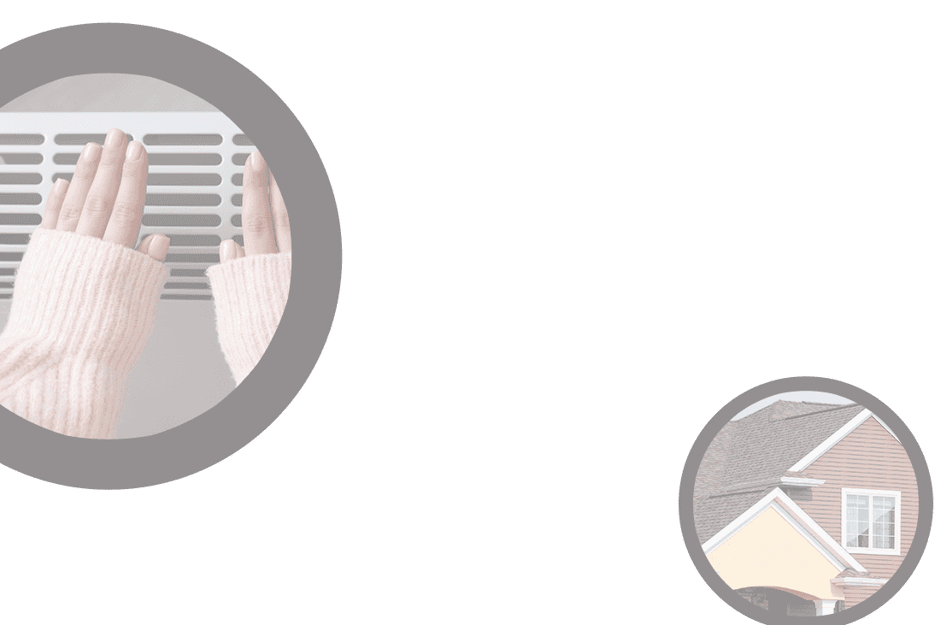
LEARN ABOUT COMMON HVAC PROBLEMS & SOLUTIONS
-
Common HVAC Problems & Solutions
Solving Heating & AC Problems in Virginia Beach
There are many common reasons we get called out for heating and AC repairs. Some of these problems are emergencies, such as steam or water coming out of your unit. Other problems may be a cause for concern, such as an unusually high electric bill. At Climatemakers, we know that heating and air conditioning systems offer great convenience. However, every type of HVAC system is prone to the occasional problem. Our Virginia Beach AC repair technicians’ goal is to find the solution to any air conditioning or heating problem you may have.
A few examples of problems we can solve include:
- Thermostat fails to maintain the temperature
- Your heat pump is blowing cold air
- The pilot light keeps going out
Whether your heat pump keeps icing, your indoor unit is leaking, or you are experiencing any other issue, we can help. In addition to offering repair and replacement services, we offer a number of resources to our clients. In the above pages, you can find answers to many common questions.
-
Water Leaks At My Indoor Unit
(Today’s mechanical code requires an auto safety switch to be installed on all new equipment to protect against water damage)
Under no circumstances should you ever see water around the indoor unit. This is a sign that something is either leaking or dripping not draining. Although an AC repair like this needs prompt attention, sometimes it is only a very minor problem.
In the cooling mode, the indoor evaporator coil and the suction line sweats. That’s why it is wrapped in black insulation. If the insulation is missing or has been torn or split, it can cause dripping. Obviously this is easy to repair.
The evaporator produces a lot of water during the summer as it removes excess humidity from the air. The water runs down the outside of the coil into a pan that has a drain. The drain goes outside the house into a gutter or directly to the ground.
If the coil is dirty, the water mixes with the dirt; the dirty water ends up in the pan, the drain trap or anywhere else it can cause a problem. As the water flows by gravity, it doesn’t take much dirt to clog a drain and if your coil is located in the attic or finished room, serious damage can result. This is a very important reason for having clean filters and an annual inspection that includes coil cleaning.
Sometimes the indoor coil actual ices up. When the ice melts, excessive water all over the floor or ceiling is the result.
Indoor water problems are not just limited to summer. Some of today’s high efficiency furnaces also produce condensation, which must be drained. A central humidifier also can cause leaks. All of these things emphasize the necessity for annual inspections plus you should always keep your eyes open for water, as it is a sure sign that something is amiss. Sometimes it is a simple fix; sometimes not.
Below is a list of possible causes and things to check. Items in blue can be addressed or fixed by the homeowner. Those that are bolded usually require a service call.
- Suction line missing insulation
- Drain line moved or not pitched downward
- Floor drain clogged with dirt
- Leaking humidifier
- Blocked pan, trap or drain
- Indoor coil frozen due to malfunction
- Dirty or defective evaporative coil
- Cracked condensate pan
- Broken fittings or pipe; unglued joints
- Kinked tubing Humidifier over filling or leaking
Hope this has been of some assistance, however they are just rough guidelines and not all possible conditions are covered.
-
My Outdoor Unit Will Not Shut Off
It only happens occasionally. Thermostat satisfied; indoor blower goes off; outdoor unit continues to run and can only be turned off with circuit breaker.
Only 2 or 3 things can cause this. The most common is a stuck compressor contactor. Located in the outside unit, the contacts get pitted and eventually weld shut. This can cause serious damage. Some authorities think it is good practice to replace the contactor every few years just like you would replace the spark plugs in an automobile. Other causes would be a shorted thermostat cable or a defective thermostat.
Below is a list of possible causes and usually require a service technician to correct:
- Stuck contactor
- Defective thermostat
- Thermostat cable shorted
Hopefully, this has been of some assistance, however they are just rough guidelines and not all possible conditions are covered. Get advice on AC repair from one of our trained and licensed techs to be sure you are on the right track.
-
My Outdoor Unit Will Not Come On
This is not an unusual problem whether it is an air conditioner or heat pump. Unfortunately, many times the service technician finds a simple solution that the homeowner could have easily corrected and saved both the cost of a service call plus the inconvenience.
Below is a list of possible causes. Items in blue can be addressed or fixed by the homeowner. Those in red usually require a service call.
- Thermostat not set properly
- Emergency switch or shut-off switch turned off
- Blown fuse in panel
- Circuit breaker tripped or off
- Outdoor disconnect turned off
- Off on outdoor reset button
- Unit locked out (reset by turning off then turning back on)
Here is a checklist to go through before making a service call:
- Make sure the thermostat is calling for heating/cooling
- Make sure no Emergency switches are turned off
- Make sure circuit breakers for both indoor and outdoor units are in the on position (reset for certainty)
- Make sure the outdoor disconnect is on
- Defective thermostat
- Defective contactor
- Defective time-relay control
- Defective thermostat cable
- Off, on safety device (low pressure, high pressure, low temp, high temp.)
- Defective control module
Hope this has been of some assistance, however they are just rough guidelines and not all possible conditions are covered.
-
My Heat Pump Blows Cold Air
It might seem like your heat pump blows cold air because air temperatures from heat pumps (85-98 degrees) are much lower than the temperatures from gas/oil-fired systems (85-98). Because your body temperature is 98.6, it might feel cold, but 85-98 degree air is what you should expect from your heat pump.
There are actually two possible explanations for this observation.
- You think your heat pump is blowing cold air.
- Your heat pump really is blowing cold air.
The aforementioned misperception usually only happens to new heat pump owners. To determine which of the possibilities above is going on, try measuring the air temperature at the supply and return register. If there is no difference between the two, then there is a problem.
Heat Pump Blowing Cold Air Instead of Heat
If the heat pump really is blowing cold air, not putting out any warm air at all there could be several things wrong.
Below is a list of possible causes. Items in blue can be addressed or fixed by the homeowner. Those in red usually require a service call.
- Snow drift leaves against outdoor unit
- Outdoor unit iced up-weather related
- Return duct leakage
- Cold return temperatures i.e., air handler in attic/crawl space disconnected from pulling in cold air
- Thermostat set below 65 degrees
- Low refrigerant charge
- Refrigerant flow related problem
- Restriction/defective metering device
- Poor efficiency-needs cleaning & servicing
- Defective reversing valve
- Defective compressor valves
- Compressor not running
- Running in A/C mode
- Outdoor unit iced up because of a malfunction
Hope this has been of some assistance, however they are just rough guidelines and not all-possible conditions are covered.
-
My Heat Pump Ices in the Summer
It is never normal to see ice in the summer anywhere on a heat pump or a central air conditioner. This includes:
- The indoor unit.
- The outdoor unit.
- Refrigerant lines.
If you see ice on a heat pump or air conditioner in the summer, there most likely is a problem. Below is a list of possible causes. Items in blue can be addressed or fixed by the homeowner. Those in red usually require a service call by a repair tech.
- Clogged or blocked air filter
- Supply and/or Return vents closed
- Running air conditioners with windows opened
- Setting thermostat too low
- Bad indoor fan motor-not running/running too slow
- Loose, worn, or broken fan belt
- Bad indoor fan relay
- Clogged blower wheel
- Low refrigerant charge
- Refrigerant restriction
- Blocked capillary tube
- Blocked orifice
- Defective expansion valve
- Stuck compressor contractor
- Defective thermostat
- Dirty or damaged indoor coil
Hope this has been of some assistance, however they are just rough guidelines and not all possible conditions are covered.
-
My Heat Pump Ices in the Winter
Heat pumps do ice up in winter. It is normal for the entire coil to be covered in a white frost or even light ice during certain weather conditions. Heat pumps will naturally ice up in winter but will periodically go into a defrost cycle to defrost the coils. This keeps the unit running efficiently.
It is not normal, however, for the entire unit to be encased in ice for an extended period of time. Proper heat transfer between the outside air and the freon can not occur if the coils are blocked by ice. This would indicate a problem and should be addressed quickly to avoid serious damage to the equipment.
Different heat pumps have different ways of determining when to go into defrost. Some are mechanical; others use solid state controls with temperature sensors but all must go into defrost to keep from icing up.
There are many other reasons why a heat pump can ice up. Listed below are some of them. Items in blue can be addressed or fixed by the homeowner. Those in red usually require a service call.
- Outdoor coil blocked-possibly with leaves or snow
- Condenser platform has sunk-nowhere for ice to melt and drain
- Leaking gutter dripping water onto top of unit
- Freezing rain-causes top of unit to freeze over. If this happens rest of unit will also freeze over
- Defective defrost control or timer
- Defective defrost thermostat or sensor
- Defective defrost relay
- Sticking reversing valve
- Defective reversing valve solenoid
- Defective outdoor fan motor
- Low refrigerant charge
- Refrigerant restriction
Hope this has been of some assistance, however they are just rough guidelines and not all possible conditions are covered.
-
Steam is Coming Out of my Outdoor Unit
When new heat pump owners first think they see steam coming from their heat pump, they are sure the outdoor fan is burning up. This feeling is further enhanced when the motor also stops running.
Don’t worry, this is a good thing. It is your unit going into its defrost mode. It happens regularly during the heating season. The outdoor coils tend to frost or ice-up during the winter. This causes the unit to lose efficiency. By regularly defrosting itself, the heat pump runs more efficiently.
When the unit goes into defrost, several things happen. First, the outdoor fan stops running. This helps build up more heat to melt the ice. Also the reversing valve shifts from the heating mode to the air conditioning mode. Temporarily making the outdoor unit a condenser, the hot refrigerant passing through the coils accomplishes the necessary defrosting. At the same time, the supplemental heat is energized to temper the otherwise cold air that would be blowing into the house.
At first glance this seems bizarre to say the least (running the air conditioning and heating at the same time) but it usually is only for a few minutes at a time and only when needed. If your unit is constantly going into defrost, this could indicate a problem.
Below is a list of possible causes. Items in blue can be addressed or fixed by the homeowner. Those in red usually require a service call.
- Outdoor coil blocked-possibly with leaves
- Defective defrost control
- Defective defrost sensors or thermostats
- Defective outdoor fan motor
- Low refrigerant charge or a restriction
Hope this has been of some assistance, however they are just rough guidelines and not all possible conditions are covered.
-
My Outdoor Unit Makes Loud / Strange Noises
Outside AC Unit Making Loud Noise
Heat pumps do make strange loud noises especially in the wintertime. It’s just the nature of the beast. i.e., heat pumps have reversing valves that reverse (or shifts) the flow of refrigeration between the heating and cooling modes. This occurs every time the unit goes into the “defrost cycle”.
When this shifting occurs, there is a loud “swooshing” sound, which usually lasts for several seconds. The “swooshing” sound is sometimes followed by a somewhat louder than normal compressor noise as it shuts down to allow the refrigerant pressures to equalize. All these noises are perfectly normal.
Another common sound is present whenever the outside condenser turns “off” or “on”. For a few seconds it sounds like an out of balance washing machine.
Sometimes customers note a “buzzing” sound from the outdoor unit. even when it’s not running. This is usually the reversing valve’s solenoid coil. It’s low voltage (only 24 volts) so it’s really not wasting energy.
If you hear a metal to metal sound or a persistent “thumping” sound, check the fan blade of the compressor to see if the blade can be hitting something (ice, wire, twig). Shut the unit off, immediately as this not only will ruin the fan blade by throwing it “out of balance” but if allowed to persist, ruin the fan motor as well.
And there is always “vibration” noise. Sometimes its only a matter of installing (or replacing) isolation pads. Sometimes the refrigerant lines are strapped too tight. Sometimes it is the unit itself and cannot be eliminated.
Below is a list of possible causes. Items in blue; can be addressed or fixed by the homeowner. Those in red usually require a service call.
- Outdoor unit iced up-weather related
- Fan blades hitting some obstruction
- Vibration due to out of balanced fan blade
- Vibration due to loose parts
- Vibration due to piping strapped too tight
- Low refrigerant charge (gurgling noise)
- Defective reversing valve-makes hissing sound
- Defective compressor valve
- Defective motor
- Out of balanced or bent fan blades
- Buzzing contactor or solenoid coil
- Loud compressor
- Loud unit
Hope this has been of some assistance, however they are just rough guidelines and not all possible conditions are covered.
-
Why Is My Electric Bill So High?
Many things can cause high electric bills. These could range from a mistake by the electric company, old, inefficient appliances like water heaters, freezers, refrigerators or just poorly insulated houses all wasting energy.
Ruling these things out, that leaves one main culprit… the heating system, especially if it is a heat pump. Of course the electric bill will be higher during the coldest months because that’s when the supplementary heat is on the most. But after taking these things into consideration, if the electric bill is higher than normal, it is very possible that there could be a problem with the heat pump.
These problems can range from minor things like a dirty filter to a major item like a damaged compressor. Some of them are listed below. Items in blue can be addressed or fixed by the homeowner. Those in red usually require a service call.
- Outdoor unit iced up-weather related
- Snow drift / leaves against outdoor unit
- Outdoor unit not running, using back-up heat
- Dirty air filter
- Poorly insulate house/air leaks
- Outdoor unit not running, using back-up heat
- Low refrigerant charge
- Refrigerant flow related problem/restriction/defective-metering device
- Defective reversing valve
- Bad compressor valves
- Running in A/C mode
- Outdoor unit iced up because of malfunction
- Undersized equipment and/or ductwork
Hope this has been of some assistance, however they are just rough guidelines and not all possible conditions are covered.
-
My Thermostat Doesn’t Maintain Temperature
This is usually caused by a thermostat that isn’t properly calibrated. This can be a nuisance call because older thermostats are mercury styled and after being calibrated can shortly lose their calibration.
One solution is the new digital thermostats. They never lose calibration and most have additional programmable features that can save customers 20-30% in fuel costs.
However, there are other things that can cause this problem besides the thermostat. Below is a list of possible causes and things to check. Items in blue can be addressed or fixed by the homeowner. Those in red usually require a service call.
- Direct sun or another heat source hitting thermostat
- Thermostat not level
- Draft through hole in wall behind
Hope this has been of some assistance, however they are just rough guidelines and not all possible conditions are covered.
-
Why Does My Circuit Breaker Keep Tripping?
Circuit breakers are safety devices, so if your circuit breaker keeps tripping it’s for you and your home’s safety. The following are the most common causes of tripping your circuit breaker:
- Loose electrical connections
- A weak breaker
- A thunderstorm
- A direct short
- Malfunctioning compressor
- Defective capacitor
One very common cause for breakers to trip are loose electrical connections and can easily be corrected by tightening them. Try one time to reset it by turning it to the “off” position and then back to the “on” position. Do not just keep resetting it and try to ignore the situation. It is trying to tell you something.
And while it may be just a weak breaker or the result of a thunderstorm, always remember that you are dealing with high voltage, high amperage and possibly high temperatures which can cause serious damage to life and property. Note that breakers should not feel hot to the touch. If it is hot, it indicates a problem and not to be ignored.
For example, if when you reset it, it immediately trips, that is usually indicative of a direct short. Do not even try to reset the breaker again.
Sometimes the breaker for the outside unit trips because the compressor is having a hard time starting and will require a “hard start” kit to get it going again or it may be as simple as replacing a defective capacitor.
Below is a list of possible causes and things to check. Items in blue can be addressed or fixed by the homeowner. Those in red usually require a service call.
- Severe thunderstorm
- Low voltage to the house as in a brown-out
- Weak compressor
- Under-sized breaker or wire
- Defective breaker
- Loose breaker
- Loose electrical connection
- Weak capacitor
- Locked up motor or compressor
Hope this has been of some assistance, however they are just rough guidelines and not all possible conditions are covered.

Exclusive Specials & Coupons

What Makes Climatemakers Stand Out?
-
Pro Dealer of Top-of-the-Line Products Such as Trane and Rinnai
-
Offering Military and Senior Citizen Discounts
-
Background-Checked, Licensed, Insured and NATE-Certified Technicians
-
Locally Grown and Family-Owned Since 1953
-
After Hours Emergency Services Available


Hear from Our Satisfied Customers
-
"I'm a very happy customer!"Drove in a very clean company van and started working after introducing himself. Excellent communication and inspection of HVAC.- Christian S.
-
"They just did a great job! I recommend them unconditionally!"Anthony was great: informative, patient and friendly, but very focused and hardworking through the long day of gas furnace/AC installation.- Patricia S.
-
"Top notch!!"He is a pleasant person who gives a darn about others and does his job with integrity.- Thomas P.
-
"Garry was courteous, professional & efficient."He answered all my questions & provided suggestions on operation of equipment for which I do not have a service contract.- Michael I.
-
"Great service. Problem solved."Technicians were very competent and thorough. I know when Colin is one of them I can feel confident.- Barbara W.
-
"Take care of this man and protect him at all cost!!"Working with Mr. Johnson is always a pleasure. He’s very personable, knowledgeable and kind; I would prefer him be my technician at every visit.- Tiffany R.
-
"Great team and knowledgeable service!"Thank you Gary for getting our home up and running until we could schedule a new system install!- Michael A.
-
"Took time to answer any & all questions."They even went as far as service after the sell by submitting all of the Warranty information for me.- B. Johnson
